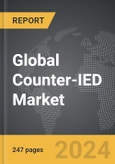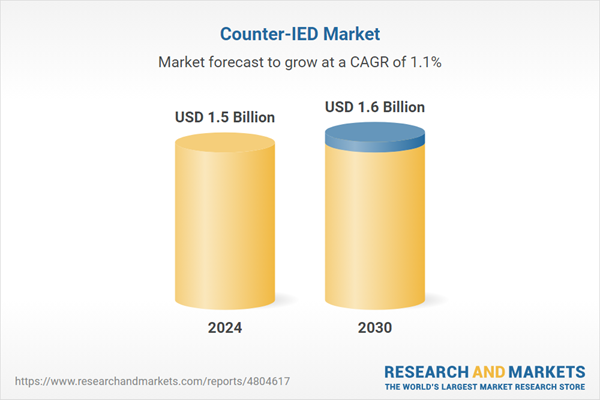Global Counter-IED Market - Key Trends and Drivers Summarized
Defusing Danger: How Effective Is Modern Counter-IED Technology?
Improvised Explosive Devices (IEDs) have long been a preferred tool for terrorists and insurgents, presenting serious threats to military and civilian populations around the world. The development of Counter-Improvised Explosive Device (Counter-IED) technology is crucial in mitigating these threats. Counter-IED strategies encompass a broad spectrum of methods and technologies designed to detect, neutralize, and investigate IEDs. These range from electronic countermeasures and advanced detection equipment to intelligence operations and training programs that educate troops and security forces on threat awareness and response. As IEDs continue to evolve in complexity and sophistication, integrating a variety of triggering mechanisms and concealment methods, the countermeasures must equally advance to protect lives and infrastructure effectively.What Are the Core Technologies Driving Counter-IED Efforts?
At the heart of counter-IED operations are several cutting-edge technologies designed to detect and neutralize these deadly devices before they can cause harm. Ground-penetrating radar and advanced metal detectors are used extensively to locate IEDs hidden underground or within structures. Robotics plays a crucial role, with bomb disposal robots being deployed to disarm IEDs, allowing for safe examination and disposal without direct human contact. Additionally, electronic warfare technologies, such as jammers, are used to prevent the remote detonation of wireless IEDs, effectively cutting off communication between the device and its operator. These technologies are continually refined to adapt to new threats, such as the increasing use of non-metallic materials in bomb construction, which requires more sensitive detection tools.Challenges in Counter-IED Operations: What Are the Obstacles?
Despite advancements in technology, counter-IED operations face significant challenges. One major difficulty is the adaptive nature of insurgents and terrorists who continually modify their IED designs to circumvent existing security measures. The variety of environments where IEDs can be deployed - urban settings, rugged terrain, and underground - further complicates detection efforts. Additionally, the integration of counter-IED technology with existing military and law enforcement tactics requires extensive training and coordination, which can be resource-intensive. Ensuring that these technologies are not only effective but also versatile and easy to deploy in a range of scenarios is a critical requirement that adds another layer of complexity to counter-IED efforts.What Factors Drive Growth in the Counter-IED Market?
The growth in the counter-IED market is driven by several factors, emphasizing the urgent need for advancements in this field. Increasing geopolitical instability and the rise in global terrorism have led to greater investments in national security measures, with a significant focus on innovative counter-IED solutions. The proliferation of non-state actors and the accessibility of materials for making IEDs have also heightened the demand for more effective countermeasures. Technological innovation, spurred by collaborations between governments and private sector experts, continues to enhance the capabilities of counter-IED equipment. Additionally, international cooperation and knowledge sharing in counter-IED techniques and technologies have been pivotal in developing integrated strategies that can be implemented across different regions and conflict scenarios. As nations and communities seek to safeguard their citizens and assets, the counter-IED market is expected to expand, reflecting the critical importance of these systems in contemporary security architectures.Report Scope
The report analyzes the Counter-IED market, presented in terms of market value (USD). The analysis covers the key segments and geographic regions outlined below.- Segments: Capability (Detection, Countermeasures); End-Use (Military, Homeland Security).
- Geographic Regions/Countries: World; United States; Canada; Japan; China; Europe (France; Germany; Italy; United Kingdom; and Rest of Europe); Asia-Pacific; Rest of World.
Key Insights:
- Market Growth: Understand the significant growth trajectory of the MilitaryEnd-Use segment, which is expected to reach US$1.3 Billion by 2030 with a CAGR of 1.3%. The Homeland Security End-Use segment is also set to grow at 0.2% CAGR over the analysis period.
- Regional Analysis: Gain insights into the U.S. market, valued at $386.8 Million in 2024, and China, forecasted to grow at an impressive 0.9% CAGR to reach $248.2 Million by 2030. Discover growth trends in other key regions, including Japan, Canada, Germany, and the Asia-Pacific.
Why You Should Buy This Report:
- Detailed Market Analysis: Access a thorough analysis of the Global Counter-IED Market, covering all major geographic regions and market segments.
- Competitive Insights: Get an overview of the competitive landscape, including the market presence of major players across different geographies.
- Future Trends and Drivers: Understand the key trends and drivers shaping the future of the Global Counter-IED Market.
- Actionable Insights: Benefit from actionable insights that can help you identify new revenue opportunities and make strategic business decisions.
Key Questions Answered:
- How is the Global Counter-IED Market expected to evolve by 2030?
- What are the main drivers and restraints affecting the market?
- Which market segments will grow the most over the forecast period?
- How will market shares for different regions and segments change by 2030?
- Who are the leading players in the market, and what are their prospects?
Report Features:
- Comprehensive Market Data: Independent analysis of annual sales and market forecasts in US$ Million from 2024 to 2030.
- In-Depth Regional Analysis: Detailed insights into key markets, including the U.S., China, Japan, Canada, Europe, Asia-Pacific, Latin America, Middle East, and Africa.
- Company Profiles: Coverage of players such as Allen-Vanguard Corp., Chemring Group PLC, Elbit Systems Ltd., General Dynamics Corporation, Harris Corporation and more.
- Complimentary Updates: Receive free report updates for one year to keep you informed of the latest market developments.
Some of the 47 companies featured in this Counter-IED market report include:
- Allen-Vanguard Corp.
- Chemring Group PLC
- Elbit Systems Ltd.
- General Dynamics Corporation
- Harris Corporation
- L3 Technologies, Inc.
- Lockheed Martin Corporation
- Netline Communications Technologies (NCT) Ltd.
- Northrop Grumman Corporation
- Raytheon Company
- Sierra Nevada Corporation
- SRC, Inc.
- Thales Group
This edition integrates the latest global trade and economic shifts into comprehensive market analysis. Key updates include:
- Tariff and Trade Impact: Insights into global tariff negotiations across 180+ countries, with analysis of supply chain turbulence, sourcing disruptions, and geographic realignment. Special focus on 2025 as a pivotal year for trade tensions, including updated perspectives on the Trump-era tariffs.
- Adjusted Forecasts and Analytics: Revised global and regional market forecasts through 2030, incorporating tariff effects, economic uncertainty, and structural changes in globalization. Includes historical analysis from 2015 to 2023.
- Strategic Market Dynamics: Evaluation of revised market prospects, regional outlooks, and key economic indicators such as population and urbanization trends.
- Innovation & Technology Trends: Latest developments in product and process innovation, emerging technologies, and key industry drivers shaping the competitive landscape.
- Competitive Intelligence: Updated global market share estimates for 2025, competitive positioning of major players (Strong/Active/Niche/Trivial), and refined focus on leading global brands and core players.
- Expert Insight & Commentary: Strategic analysis from economists, trade experts, and domain specialists to contextualize market shifts and identify emerging opportunities.
Table of Contents
Companies Mentioned (Partial List)
A selection of companies mentioned in this report includes, but is not limited to:
- Allen-Vanguard Corp.
- Chemring Group PLC
- Elbit Systems Ltd.
- General Dynamics Corporation
- Harris Corporation
- L3 Technologies, Inc.
- Lockheed Martin Corporation
- Netline Communications Technologies (NCT) Ltd.
- Northrop Grumman Corporation
- Raytheon Company
- Sierra Nevada Corporation
- SRC, Inc.
- Thales Group
Table Information
| Report Attribute | Details |
|---|---|
| No. of Pages | 176 |
| Published | December 2025 |
| Forecast Period | 2024 - 2030 |
| Estimated Market Value ( USD | $ 1.5 Billion |
| Forecasted Market Value ( USD | $ 1.6 Billion |
| Compound Annual Growth Rate | 1.1% |
| Regions Covered | Global |









